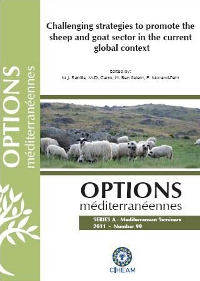| Article précédent | p. 337-342 | Article suivant |
Milk production and fatty acid profile after three weeks of diet supplementation with sunflower oil and marine algae in dairy ewes
This work was conducted to investigate the effect of supplementation of diets for dairy ewe with sunflower oil (SO) and incremental levels of marine algae (MA) on animal performance and milk fatty acid (FA) profile. Fifty Assaf ewes in mid-lactation, distributed in 10 lots of 5 animals each, were allocated to 5 treatments (feeding regimes; 2 lots/treatment). All animals received a total mixed ration either without lipid supplementation (Control) or supplemented with 25 g SO/kg plus 0, 8, 16, or 24 g MA/kg (SO, SOMA1, SOMA2, and SOMA3, respectively). Milk production and composition were recorded after 3 weeks on treatments. SO plus the highest level of algae supplement (SOMA3) resulted in the highest cis-9 trans-11 CLA content of milk fat (3.89 vs 1.58 and 0.48 percent of total FA for SOMA3, SO and Control diets, respectively), while the atherogenicity index decreased in all supplemented treatments as compared with the Control (P<0.01) but with no differences between them. On the other hand, although there were no significant differences in DM intake and milk production between treatments, milk fat content decreased in all ewes fed marine algae (-21 percent; P<0.001). The joint action of some biohydrogenation intermediates is discussed to explain these differences.
Ce travail a été mené pour étudier l´effet d'un régime à base d'huile de tournesol (SO) et de quantités croissantes d'algues marines (MA) sur des brebis laitières ainsi que sur le profil des acides gras (FA) de leur lait. Cinquante brebis Assaf en mi-lactation, réparties en 10 groupes (n=5) ont été soumises à 5 traitements (régime: 2 groupes/traitement). Tous les animaux ont reçu une ration sans supplémentation lipidique (témoin) ou supplémentés avec 25 g SO/kg et 0, 8, 16 ou 24 g MA/kg (SO, SOMA1, SOMA2, et SOMA3 respectivement). La production ainsi que la composition du lait ont été relevées après trois semaines de traitement. La complémentation en SO et en algues marines au niveau le plus élevé (SOMA3) ont présenté la teneur la plus élevée en cis-9 trans-11 CLA dans la lait (3,89 contre 1,58 et 0,48 pour cent des FA totaux pour les régimes SOMA1, SO et le contrôle, respectivement), alors que l'index d'athérogénicité a baissé avec les traitements SO, SOMA1, SOMA2, et SOMA3, en comparaison avec le régime témoin (P<0,001). Cependant, aucune différence n'a été constatée entre les index. De l'autre côté, même s'il n'y avait pas de différence significative quant à l'ingestion de matière sèche et à la production de lait entre les traitements, la teneur en lipides du lait a chuté chez toutes les brebis recevant les algues marines (-21 pour cent; P<0,001). L'action conjointe des intermédiaires en biohydrogénation est examinée afin d'expliquer ces différences.
- [ Afficher ]
- [ Télécharger ]
- [ Exporter la citation ]
Vous pouvez télécharger la citation au format :
- [ Imprimer ]
-
Mots-clés
ACIDE GRAS POLYINSATURE, ACIDE LINOLEIQUE, BREBIS, MATIERE GRASSE DU LAITCiter cet article
Toral P.G., Gómez-Cortés P., Frutos P., Fuente M.A. de la, Juárez M., Hervás G. Milk production and fatty acid profile after three weeks of diet supplementation with sunflower oil and marine algae in dairy ewes. In : Ranilla M.J. (ed.), Carro M.D. (ed.), Ben Salem H. (ed.), Morand-Fehr P. (ed.). Challenging strategies to promote the sheep and goat sector in the current global context. Zaragoza : CIHEAM / CSIC / Universidad de León / FAO, 2011. p. 337-342. (Options Méditerranéennes : Série A. Séminaires Méditerranéens; n. 99). 13. International Seminar of the Sub-Network on Nutrition of the FAO-CIHEAM Inter-Regional Cooperative Research and Development Network on Sheep and Goats, 2009/10/14-16, León (Spain). http://om.ciheam.org/om/pdf/a99/00801576.pdf



